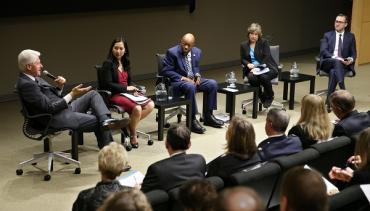The opioid epidemic is a "good news-bad news" story, former President Bill Clinton told participants at a summit on "America's Opioid Epidemic," held Oct. 30 at the Johns Hopkins Bloomberg School of Public Health in Baltimore. "The good news is that it's the first drug epidemic we're treating like a public health problem instead of primarily a criminal justice problem," he said. "The bad news is there is a woefully inadequate public health response that is not properly coordinated."
Determining how to best address the opioid epidemic was the focus of the one-day summit, co-sponsored by the Clinton Foundation's Clinton Health Matters Initiative, the Johns Hopkins Bloomberg School of Public Health, the Johns Hopkins Center for Drug Safety and Effectiveness, and the Johns Hopkins Center for Injury Research and Policy.
"The epidemic has grown like wildfire in small towns and rural areas with no public health infrastructure, where people don't know what to do, or can't do it if they know," said Clinton, who moderated a panel featuring AFT President Randi Weingarten, U.S. Rep. Elijah Cummings (D-Md.), Baltimore City Health Commissioner Leana Wen and Plank Industries CEO Tom Geddes.
Last year, more than 64,000 people died from drug overdoses in the United States, the most of any year on record. More than half of these were opioid-related, with especially large increases in deaths from heroin and fentanyl.
President Trump declared the opioid crisis a public health emergency last week—a good first step, said Cummings, who also noted that resistance to taking bold action persists in both the White House and Congress. The declaration, however, doesn't unlock additional funding or decrease the price of naloxone to help the people on the frontlines, he said. Meanwhile, we are still seeing efforts to repeal the Affordable Care Act and reverse Medicaid expansion.
Wen, the Baltimore health commissioner, who is a physician, described how naloxone has helped her city. Since she issued a blanket prescription for naloxone, Baltimore has trained 30,000 people in the use of the drug to reverse overdoses. In the last two years, residents have saved 1,500 lives, she said, but it's not enough; the city needs to expand treatment to help them long term.
Education is imperative, said Weingarten, and "it has to be coupled with quick intervention like naloxone to succeed." Weingarten shared the story of how school nurses used a grant to purchase a supply of Narcan, a device that delivers naloxone, for its school, after one them had to revive a parent. "I tell that story to help destigmatize and educate, because the pressure comes with education," she said. "I also couple it with a stick—there are a lot of worker pension funds invested in big pharma. So we are creating public pressure using these funds to reduce the price of intervention drugs."
One of the biggest challenges people face is access to effective treatment without fear of stigmatization, said Clinton, adding that healthcare professionals, employers and advocates need to think about ways to change how addiction is talked about, to reduce that stigma.
Cummings agreed. "When people find out that there are people on drugs in their midst, they look at it as a moral failing, and this makes [drug users] afraid to come forward," he said. "We must work toward getting them treatment quickly and make sure that it's effective and efficient."
But Wen noted that "even if we had enough treatment slots, we have major problems connecting people to that treatment."
"That's why it's important to address the issue of stigma," said Weingarten, pointing out if a person has a disease like cancer, they can make the necessary connection to get treatment. Cancer isn't stigmatized "because there is a sense that cancer can affect all. We have to flip the switch on stigma and figure how to do this in a way that is positive and proactive."
[Adrienne Coles]

